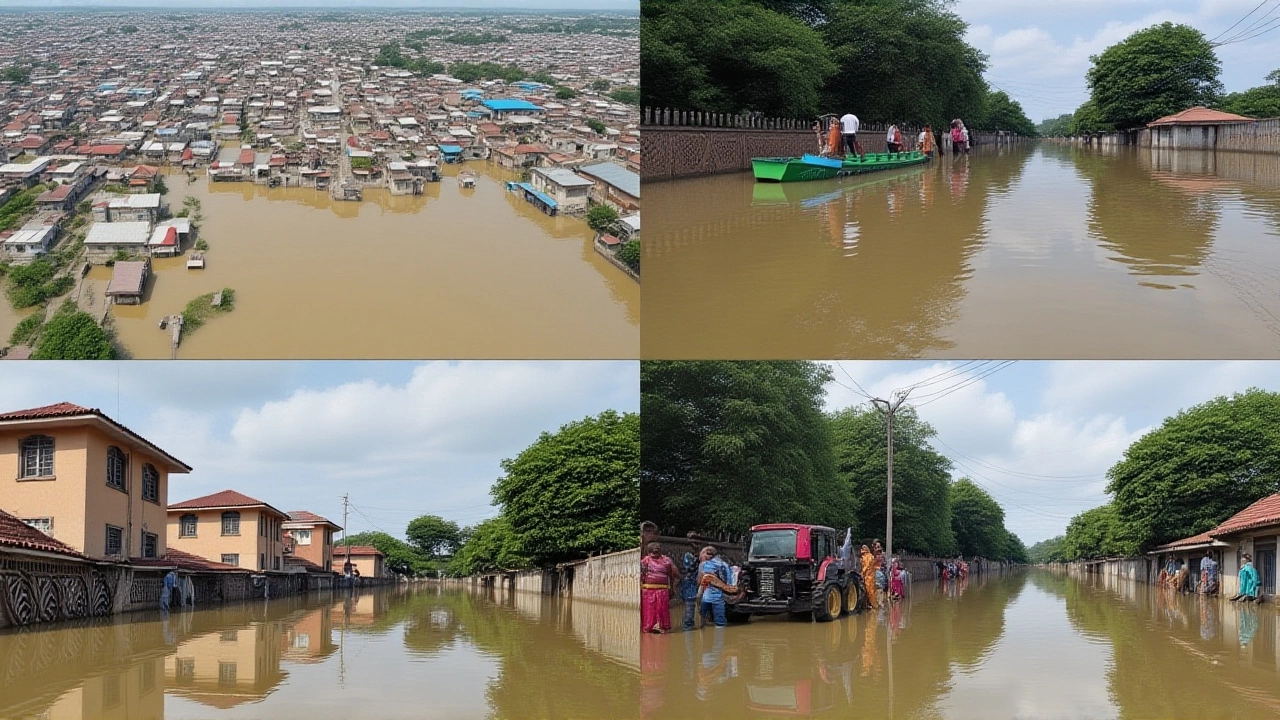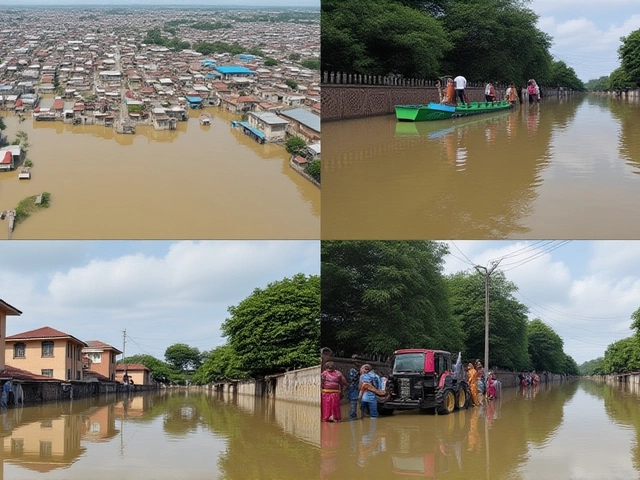During the 2025 Mathura FloodMathura, Uttar Pradesh, the Yamuna River surged to a precarious 167.04 m, breaching the danger mark for the first time since 1978. By Wednesday evening the water had receded to that level, still a full meter above the 166 m safety threshold, and the number of flood‑hit villages fell from 54 to 45. Schools across the district remained shut, with authorities extending the holiday to give families a chance to clean and repair homes.
Background and Record Flood Levels
The Yamuna’s rise began early on 9 September, when upstream releases from the Hathni Kund barrage combined with torrential monsoon showers. By Monday morning the river had crossed the danger line, touching 166.67 m, and later that afternoon it stalled at 167.64 m for several hours – a figure that eclipsed the 2023 peak of 166.9 m and even the historic 2010 high water.
Local historian Dr. Shyam Singh recalled, “The last time we saw anything close to this was the great flood of 1978. Back then, entire market streets were underwater for weeks.” The 2025 event has already broken that record, according to the Uttar Pradesh Disaster Management Authority (UPDMA), which monitors river gauges in real time.
On‑the‑Ground Impact and Relief Efforts
Residents of the Lakshminagar colony in Tivarpuram watched the water inch down after a makeshift pump set was installed by the Mathura Nagar Nigam. "The pump cleared the lower lanes, but we’re still waiting for electricity," said Suman Patel, a shop owner in the area. Power cuts have lingered for more than a week in Lakshminagar, Chiranjeevi nagla, Hangsang and Isapur, leaving families without lights or the ability to charge phones.
In the village of Hangsang, water levels have dropped to five‑six feet, a stark contrast to the eight‑to‑ten feet they held just two days earlier. Still, many villagers camp on rooftops, watching the river recede with a mixture of relief and anxiety. "We can’t leave our houses because the ground is still soft," explained Ramesh Kumar, a farmer whose fields are now a shallow lake.
The municipal relief camps, set up along the riverbank, are buzzing with volunteers distributing dry rations and blankets. Yet the biggest worry for occupants is the structural integrity of their homes. "Every gust feels like the house might collapse," whispered a mother of three as she tried to keep her children calm.
Government Response and Challenges
Chief Minister Yogi Adityanath arrived in Mathura on Thursday, meeting with district collector Anil Sharma and senior UPDMA officials. He announced an additional allocation of ₹2.3 crore for immediate relief, earmarking funds for portable generators and water purification units.
"We are deploying three teams of National Disaster Response Force (NDRF) personnel, each equipped with high‑capacity pumps," the UPDMA spokesperson Neha Verma said at a press briefing. However, the logistics of moving equipment through water‑logged streets remain a nightmare. Boats have become the primary mode of transport for health workers delivering medicine.
School principal Mrs. Priya Joshi of Shri Krishna Inter College warned that the extended holiday could disrupt exams for over 2,000 students. "We are trying to set up temporary classrooms in dry shelters, but it’s a scramble," she added.

What the Numbers Tell Us
- Peak water level: 167.64 m (Monday, 12 Sept)
- Current level: 167.04 m (Wednesday, 14 Sept)
- Average recession rate: ~1 cm per hour over the past 12 hours
- Villages still under water: 45 (down from 54)
- Power outages affecting >150,000 residents
Experts note that the recession speed, while encouraging, is not uniform. "The river’s gradient near Vrindavan is shallower, so water hangs around longer," explained hydrologist Dr. Ananya Ghosh. The slower draw‑down in the eastern banks means that market areas like Vishram Ghat and Swami Ghat remain partially submerged, turning streets into makeshift canals.
Looking Ahead: Recovery Timeline
Authorities project that it will take three to four days for water levels to fall below the 166 m threshold, after which cleanup crews can begin large‑scale de‑watering. In the meantime, the focus is on restoring electricity and safe drinking water. Portable water tanks are being shipped from Lucknow, and the state electricity board has promised to prioritize the restoration of supply to the most affected colonies.
“We expect normalcy to return by early next week,” said UPDMA chief Dr. Rajeev Kumar. Yet he cautioned that rebuilding homes and reviving local businesses could take weeks.
For residents, the flood has become a new reality that blurs the line between disaster and daily life. As the Yamuna finally begins its slow retreat, the city braces for the long haul of repairs, compensation claims, and the psychological toll of having watched their streets turn into rivers.
Frequently Asked Questions
How are schools affected by the Mathura flood?
All schools in the districts of Mathura and Vrindavan have remained closed since 9 September. The education department extended the holiday to allow families to clean homes and for authorities to assess structural safety. Temporary classrooms are being set up in relief shelters, but exams for roughly 2,000 students may be postponed.
What steps has the Uttar Pradesh government taken?
Chief Minister Yogi Adityanath announced an extra ₹2.3 crore for emergency supplies, deployed three NDRF teams with high‑capacity pumps, and ordered portable generators for power‑cut zones. The UPDMA is coordinating water‑purification units and has placed additional personnel in flood‑prone colonies.
Which areas remain underwater?
The hardest‑hit zones include Lakshminagar, Hangsang, Isapur, Shanti Ashram, and the banks of Vishram Ghat and Swami Ghat in Vrindavan. As of Wednesday, water depth in these places ranges from two to six feet, keeping markets and residential lanes inaccessible.
How does the 2025 flood compare to previous events?
The 2025 flood set a new record for the Yamuna in Mathura, surpassing both the 2023 peak (166.9 m) and the historic 1978 high water. Unlike earlier floods, this event has seen a faster rise due to simultaneous upstream releases and intense local rainfall, leading to broader inundation across both Mathura and Vrindavan.
What is the expected timeline for normalcy?
Officials say water levels should dip below the danger mark within three to four days, after which de‑watering and cleaning can begin in earnest. Full restoration of electricity, water supply, and market activity is projected for early next week, but rebuilding homes may take several weeks.




